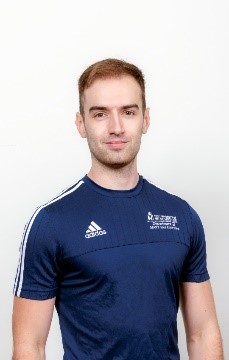Abstract
Badminton practice designs contain feeding routines that allow players to practice technical skills. Optimal skill acquisition and development is gained through practice simulating competitive match play rather than approaches centred around mass repetition with low levels of uncertainty. This study aimed to evaluate the biomechanical differences in twelve youth elite UK badminton players in activities with varying levels of predictability. The three experimental trials were handfeed, multifeed and match play trials. Motion capture cameras were used to record participant biomechanical data. Data analysis revealed several significant biomechanical differences between trials. Results showed that an increase in trial unpredictability led to increased depth of the forward lunge shot and a lower racket shuttlecock strike position with greater forward trunk bend. This study showed that visual search behaviour in badminton is a key component of the forward lunge shot. Predictable practice feeding routines may cause poor skill acquisition and development through maladaptive learning behaviours. Coaches are recommended to implement unpredictable feeding practice routines to simulate the visual search behaviour of competitive badminton match play to enhance skill acquisition and development in youth elite badminton players.
Keywords
Visual Search Behaviour, Representative Learning Design, Ecological Dynamics, Practice,References
- M. Phomsoupha, G. Laffaye, The Science of Badminton: Game Characteristics, Anthropometry, Physiology, Visual Fitness and Biomechanics, Sports Medicine, 45(4) (2015) 473-495.
- V. Correia, J. Carvalho, D. Araújo, E. Pereira, K. Davids, Principles of Nonlinear Pedagogy in Sport Practice, Physical Education and Sport Pedagogy, 24(2) (2019) 117-132.
- K. Davids, D. Araújo, L. Vilar, I. Renshaw, R. Pinder, An Ecological Dynamics Approach to Skill Acquisition: Implications for Development of Talent in Sport, Talent Development & Excellence, 5(1) (2013) 21–34.
- L. Krause, D. Farrow, T. Buszard, R. Pinder, M. Reid, Application of Representative Learning Design for Assessment of Common Practice Tasks in Tennis, Psychology of Sport and Exercise, 41 (2019) 36-45.
- R. J. Martindale, D. Collins, A. Abraham, Effective Talent Development: The Elite Coach Perspective in UK Sport, Journal of Applied Sport Psychology, 19(2) (2007) 187-206.
- Level 2 – BWF Development, Development.bwfbadminton.com. (2021), https://development.bwfbadminton.com/coaches/level-2
- M. U. Aslam, A. Bashir, W. U. Draz, H. M. M. Raja, Optimized Shuttlecock Propulsion Machine to Facilitate Badminton Training, 2019 International Conference on Electrical, Communication, and Computer Engineering, (2019) 1-6.
- A. P. G. De Alwis, C. Dehikumbura, M. Konthawardana, T. D. Lalitharatne, V. P. C. Dassanayake, Design and Development of a Badminton Shuttlecock Feeding Machine to Reproduce Actual Badminton Shots, 2020 5th International Conference on Control and Robotics Engineering, (2020) 73-77.
- R. A. Pinder, K. Davids, I. Renshaw, D. Araújo, (2011) Manipulating Informational Constraints Shapes Movement Reorganization in Interceptive Actions, Attention, Perception, & Psychophysics, 73(4) 1242-1254.
- L. Lobo, M. Heras-Escribano, D. Travieso, The History and Philosophy of Ecological Psychology, Frontiers in Psychology, 9 (2018) 2228.
- C. T. Woods, I. McKeown, M. Rothwell, D. Araújo, S. Robertson, K. Davids, Sport Practitioners as Sport Ecology Designers: How Ecological dynamics has Progressively Changed Perceptions of Skill “Acquisition” in the Sporting Habitat, Frontiers in psychology, 11 (2020) 654.
- P. R. Browne, C. T. Woods, A. J. Sweeting, S. Robertson, (2020) Applications of a Working Framework for the Measurement of Representative Learning Design in Australian Football, PloS one, 15(11) e0242336.
- I. Renshaw, J. Y. Chow, K. Davids, J. Hammond, (2010). A Constraints-Led Perspective to Understanding Skill Acquisition and Game Play: A Basis for Integration of Motor Learning Theory and Physical Education Praxis?, Physical Education and Sport Pedagogy, 15(2) 117–137.
- D. Orth, K. Davids, D. Araújo, I. Renshaw, P. Passos, Effects of a Defender on Run-Up Velocity and Ball Speed When Crossing a Football, European Journal of Sport Science, 14(sup1) (2014) S316-S323.
- S. Barris, K. Davids, D. Farrow, Representative Learning Design in Springboard Diving: Is Dry-Land Training Representative of a Pool Dive?, European Journal of Sport Science, 13(6) (2013) 638–645.
- D. Alder, P. R. Ford, J. Causer, A. M. Williams, The Coupling Between Gaze Behavior and Opponent Kinematics During Anticipation of Badminton Shots, Human Movement Science, 37 (2014) 167-179.
- A. D. Gorman, M. A. Maloney, Representative design: Does the Addition of a Defender Change the Execution of a Basketball Shot?, Psychology of Sport and Exercise, 27 (2016) 112-119.
- J. M. Wolfe, T. S. Horowitz, Five Factors That Guide Attention in Visual Search, Nature Human Behaviour, 1(3) (2017) 1-8.
- J. K. Witt, M. A. Riley, Discovering Your Inner Gibson: Reconciling Action-Specific and Ecological Approaches to Perception–Action, Psychonomic Bulletin & Review, 21(6) (2014) 1353-1370.
- L. Fu, F. Ren, J. S. Baker, Comparison of Joint Loading in Badminton Lunging Between Professional and Amateur Badminton Players, Applied Bionics and Biomechanics, 2017, (2017) 1-8.
- G. Kuntze, N. Mansfield, W. Sellers, A Biomechanical Analysis of Common Lunge Tasks in Badminton, Journal of Sports Sciences, 28(2) (2010) 183-191.
- R. Valldecabres, C. A. Casal, J. G. C. Chiminazzo, A. M. De Benito, Players’ on-Court Movements and Contextual Variables in Badminton World Championship, Frontiers in Psychology, 11 (2020) 1567.
- L. Yu, Q. Mei, N. I. Mohamad, Y. Gu, J. Fernandez, An Exploratory Investigation of Patellofemoral Joint Loadings During Directional Lunges in Badminton, Computers in Biology and Medicine, 132 (2021) 104302.
- Y. Le Meur, C. Hausswirth, F. Natta, A. Couturier, F. Bignet, P. P. Vidal, A Multidisciplinary Approach to Overreaching Detection in Endurance Trained Athletes, Journal of Applied Physiology, 114(3) (2013) 411-420.
- S. J. Maloney, Review of the Badminton Lunge and Specific Training Considerations, Strength & Conditioning Journal, 40(4) (2018) 7-17.
- A. M. Nadzalan, S. H. Azmi, N. I. Mohamad, J. L. F. Lee, K. Tan, C. Chinnasee, Kinematics Analysis of Dominant and Non-Dominant Lower Limb During Step and Jump Forward Lunge in Badminton, Journal of Fundamental and Applied Sciences, 10(3S) (2018) 232-242.
- S. Jönhagen, P. Ackermann, T. Saartok, Forward Lunge: A Training Study of Eccentric Exercises of the Lower Limbs, The Journal of Strength & Conditioning Research, 23(3) (2009) 972-978.
- W. Gawin, C. Beyer, H. Hasse, D. Büsch, How to Attack the Service: An Empirical Contribution to Rally Opening in World-Class Badminton Doubles, International Journal of Performance Analysis in Sport, 13(3) (2013) 860-871.
- M. T. Huang, H. H. Lee, C. F. Lin, Y. J. Tsai, J. C.Liao, How Does Knee Pain Affect Trunk and Knee Motion During Badminton Forehand Lunges?, Journal of Sports Sciences, 32 (2014) 690-700.
- C. F. Lin, S. H. Hua, M. T. Huang, H. H. Lee, J. C. Liao, Biomechanical Analysis of Knee and Trunk in Badminton Players with and Without Knee Pain During Backhand Diagonal Lunges, Journal of Sports Sciences, 33(14) (2015) 1429-1439.
- M. Phomsoupha, G. Laffaye, Injuries in Badminton: A Review Blessures en badminton: une revue, Science & Sports, 35(4) (2020) 189-199.
- Y. C. Hsueh, Y. Y. Chen, K. M. Pan, C. L. Tsai, Biomechanical Analysis of Badminton Forehand Net Shots, In 30th International Conference of Biomechanics in Sports, (2012) 256-259.
- R. M. Discombe, S. T. Cotterill, Eye Tracking in Sport: A guide for New and Aspiring Researchers, Sport & Exercise Psychology Review, 11(2) (2015) 49-58.
 |
|


 Articles
Articles







